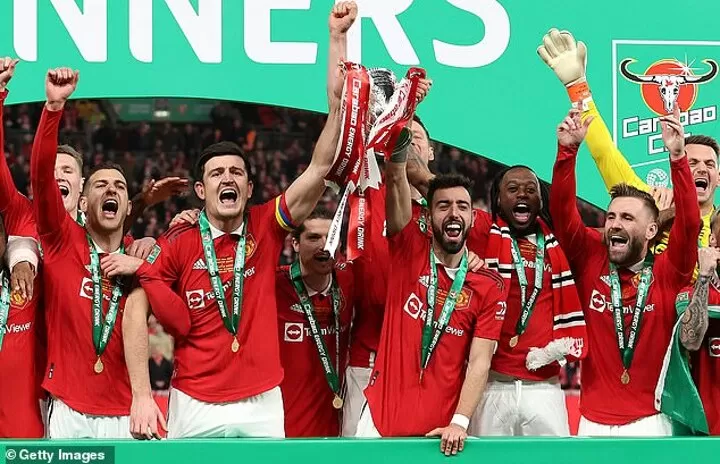Erik ten Hag has around £120million to spend on new players in his second summer window as manager of Manchester United.

United are keen to sign a goalkeeper and a striker, but have already splurged half of their budget on Mason Mount after splashing out £60m on the former Chelsea star.
Their financial uncertainty is exacerbated by the protracted takeover saga, with Qatar’s Sheikh Jassim and Ineos chief Sir Jim Ratcliffe going head-to-head in a £6bn battle to buy the club from the reviled Glazer family.
But why don’t they have more money in the bank for transfers? Here, football finance expert Kieran Maguire runs the rule over United and reveals why their budget is not as big as Ten Hag – or United fans – will have hoped.
There have been many stories over the summer in relation to Manchester United having a limited amount of leeway in relation to signing new players due to Financial Fair Play – now called Profitability and Sustainability (P&S) – issues.
Under the present rules in the Premier League, clubs are allowed to lose no more than £15million over a rolling three year period.
However, owners are allowed to increase this by putting in a further £90m in the form of shares, taking the total P&S loss up to £105m.
Manchester United are on a sticky wicket here, as a publicly listed company on the New York Stock Exchange (NYSE) it is both difficult and expensive to issue fresh shares.
Manchester United presently have about 160m shares in issue, of which about 69 per cent are owned by the Glazer family.


Since acquiring the club in 2005, the Glazers’ strategy was initially to borrow money from banks. In 2012 the club was listed on the NYSE, but the money raised came from external investors.
The Glazers have not put any equity investment into the club themselves. Therefore the club has to stay within the £15m loss limit.
United have historically been very competitive when it comes to the main cost in football, which is wages.
In 2021-22 they had a £384m wage total, the highest in the Premier League, despite not having to pay out any bonuses for winning trophies or qualifying for the UEFA Champions League.
United’s wage bill will decrease in 2022-23. This is partly due to players having contract clauses that reduce their pay if the club does not qualify for the Champions League, and also due to Cristiano Ronaldo departing the club part-way through the season.



The actual calculation of P&S losses is complex.
There are adjustments to be made for Covid issues such as loss of matchday income, broadcast rebates, and increased costs in terms of health protocols and players not being able to be in close proximity during lockdown.
In addition, costs relating to infrastructure, women’s team, academy and community activities are all excluded from the losses.
United’s operating losses for 2021-22 were modest by Premier League standards, at £37m. Five other clubs posted higher figures, with Chelsea’s being over three times the amount of United.



Operating losses can be mitigated by player sale profits, and this is one area where United have underperformed spectacularly compared to their peer group in the ‘Super League Six’.
Per the audited accounts of all the clubs, Manchester United have made just £133m in player sale profits since Sir Alex Ferguson retired in 2013.
This is over half a billion pounds less than Chelsea, who have sold the likes of Eden Hazard for big sums.
Chelsea also have turned their academy into a financial powerhouse with the sales of the likes of Tammy Abraham, Mark Guehi and Fikayo Tomori generating pure profit.
Chelsea have made more money from player sale profits over the last decade than they have generated from ticket sales at Stamford Bridge.


United chief executive Richard Arnold, who has introduced root and branch improvements to the club since superseding Ed Woodward, has instigated a ‘No d********’ policy to player recruitment.
This has the aim of not only improving the quality of players signed, but also giving the club an inventory of players that will be attractive to other clubs and profitable too.
Operating profits are reduced by the interest paid on loans. Because United has debts that presently exceed the initial sum borrowed at the Glazer takeover date, interest charges have totalled £906m since 2005, enough to buy more than eleven Harry Maguires.
This had put further constraint on the club’s ability to buy in the market.
Whilst there is a lot of criticism levelled at the Glazers, the budgets given to a succession of managers have been competitive.
Only Chelsea have spent more than United over the last decade. It could be argued that United have spent big rather than wisely on signings, which is reflected in the poor level of player sales.


A new owner, especially if they chose to take the club private and inject money in the form of new shares, combined with a repayment of debt, would give Ten Hag a potentially bigger budget.
History, however, suggests that spending it well has been United’s Achilles heel though rather than the size of the budget.

3 responses to “Why Man United can’t spend big in the summer transfer window: Crippling debt, poor sales and more”
[…] Sport Updates: Why Man United can’t spend big in the summer transfer window: Crippling debt, poor sales and m… & Tonali completes his move from AC Milan to […]
LikeLike
[…] Sport Updates: Why Man United can’t spend big in the summer transfer window: Crippling debt, poor sales and m… & Tonali completes his move from AC Milan to […]
LikeLike
[…] Sport Updates: Why Man United can’t spend big in the summer transfer window: Crippling debt, poor sales and m… & FIFA consider offside rule change to impact Arsenal, Chelsea and […]
LikeLike